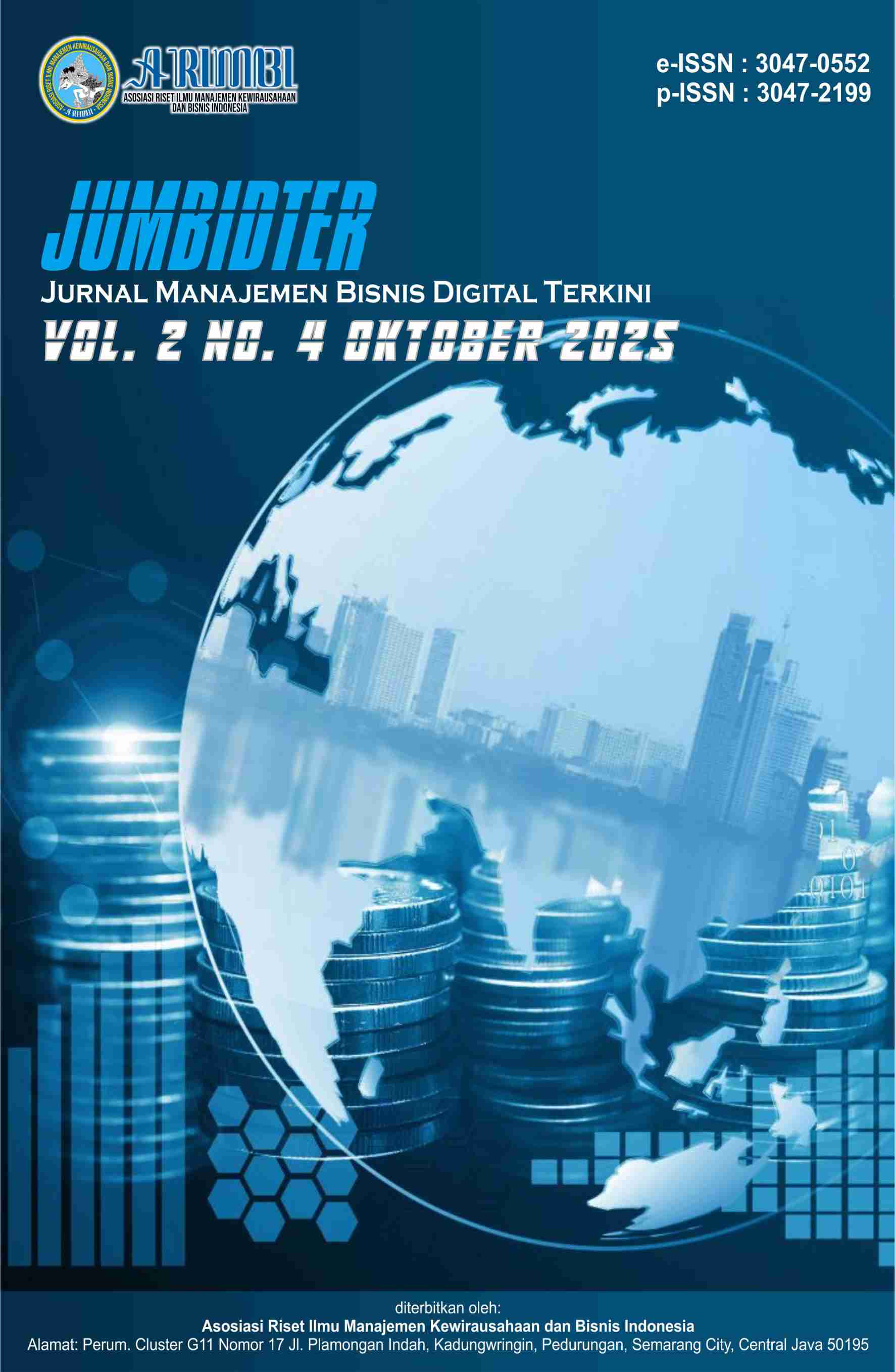Analisis Pengaruh Makroekonomi Terhadap Capital Adequency Ratio (CAR) pada Bank Konvensional yang Terdaftar di BEI pada Periode 2020-2024
DOI:
https://doi.org/10.61132/jumbidter.v2i4.920Keywords:
Capital Adequacy Ratio, Conventional Banks, Gross Domestic Product, Inflation, Interest RateAbstract
Banking stability plays a crucial role in maintaining financial system resilience and supporting national economic growth. Fluctuations in macroeconomic factors often impact banks' financial health, particularly their capital. This study aims to explore how macroeconomic factors such as inflation, central bank benchmark interest rates, and gross domestic product (GDP) impact capital adequacy ratio (CAR) in conventional banks listed on the Indonesia Stock Exchange (IDX) from 2020 to 2024. This study employed a quantitative approach with an associative design, utilizing secondary data. The sample size for this study was 43 conventional banks. Data analysis was performed using multiple linear regression using SPSS. The findings indicate that inflation and benchmark interest rates do not significantly impact financial health, while GDP indicators show a modest positive trend. These findings confirm that macroeconomic conditions are not yet a dominant factor in determining bank capital adequacy. Therefore, it is suspected that internal factors such as risk management, profitability, and operational efficiency play a greater role in maintaining bank capital stability.
Downloads
References
Afifah, L. N., & Prajawati, M. I. (2022). Pengaruh struktur modal, kebijakan hutang, dan kepemilikan manajerial terhadap nilai perusahaan dengan profitabilitas sebagai variabel moderasi. Jurnal Ilmiah Manajemen, 7(4), 901–911.
Aiman, U., Abdullah, K., Jannah, M., Hasda, S., Fadilla, Z., Masita, S., Sari, M. E., & Ardiawan, K. N. (2022). Metodologi penelitian kuantitatif. Yayasan Penerbit Muhammad Zaini.
Andersen, H., & Juelsrud, R. E. (2024). Optimal capital adequacy ratios for banks. Latin American Journal of Central Banking, 5(2), 100107. https://doi.org/10.1016/j.latcb.2023.100107
Aziza, N. (2023). Metodologi penelitian 1: Deskriptif kuantitatif. ResearchGate, July, 166–178.
Bhattarai, B. P. (2020). Determinants of capital adequacy ratio commercial banks in Nepal. Asian Journal of Finance & Accounting, 12(1), 194–210. https://doi.org/10.5296/ajfa.v12i1.17521
Dao, B. T. T., & Nguyen, K. A. (2020). Bank capital adequacy ratio and bank performance in Vietnam: A simultaneous equations framework. Journal of Asian Finance, Economics and Business, 7(6), 39–46. https://doi.org/10.13106/JAFEB.2020.VOL7.NO6.039
Das, N. M., & Rout, B. S. (2020). Banks’ capital adequacy ratio: A panacea or placebo. Decision, 47(3), 303–318. https://doi.org/10.1007/s40622-020-00255-5
Gharaibeh, A. M. O. (2023). The determinants of capital adequacy in the Jordanian banking sector: An autoregressive distributed lag-bound testing approach. International Journal of Financial Studies, 11(2), 1–15. https://doi.org/10.3390/ijfs11020075
Kablay, H., & Gumbo, V. (2021). Determinants of capital adequacy ratio of banks in Botswana. Journal of Finance and Banking Research, 9(3), 45–56.
Lanori, T., & Supriyanto, H. (2023). Analisis prilaku inflasi negara Indonesia: Tinjauan historis ekonomi dalam pusara ekonomi kerakyatan (Vol. 23, p. 126).
Mustafa, A., & Mumtaz, M. Z. (2022). Examining the bank-specific and macro-economic factors that influence capital adequacy in Pakistan. International Journal of Management Research and Emerging Sciences, 12(2), 134–157. https://doi.org/10.56536/ijmres.v12i2.221
Nga, L. P., & Ha, D. T. (2021). Factors affecting the capital adequacy ratio (CAR): A case study of joint-stock commercial banks in Vietnam. Review of Economics and Finance, 19(2), 395–402. https://doi.org/10.55365/1923.X2021.19.41
Nguyen, T. T. H., Phan, G. Q., Wong, W. K., & Moslehpour, M. (2023). The influence of market power on liquidity creation of commercial banks in Vietnam. Journal of Asian Business and Economic Studies, 30(3), 166–186. https://doi.org/10.1108/JABES-06-2021-0076
Oppusunggu, L. S., & Allo, Y. R. M. (2021). Kecakupan modal inti.
Panuntun, B. (2022). Capital adequacy ratio and factors determinant study on Islamic rural bank in Indonesia. International Journal of Islamic Economics and Finance Studies, 9(12), 112–125.
Putri, A. N., Muslim, B. M., Syafii, M. S., & Longkutoy, M. (2024). Perbankan dan lembaga keuangan: Prinsip, praktek, dan perspektif (Vol. 1).
Sari, W., Manurung, A. H., & Usman, B. (2023). Determinant of capital adequacy ratio (CAR) in Indonesia. International Journal of Science and Management Studies (IJSMS, 13, 89–98. https://doi.org/10.51386/25815946/ijsms-v6i4p112
Sateeshchandra, G., & Ray, S. (2024). Measuring the impact of the macroeconomic and bank-specific variables on capital risk: A comparative study between the listed and non-listed banks. Journal of Banking and Financial Risk Analysis, 10(3), 237–248.
Siswanto, E. (2021). Buku ajar manajemen keuangan dasar (Vol. 11, Issue 1). Penerbit Universitas Negeri Malang. http://scioteca.caf.com/bitstream/handle/123456789/1091/RED2017-Eng-8ene.pdf
Suparmono. (2018). Pengantar ekonomi makro (Terj. Chriswan Sungkono). Jakarta: Salemba Empat.
Tran, T. N. (2024). Exploring influencing factors on capital adequacy in commercial banks. Emerging Science Journal, 8(2), 527–538. https://doi.org/10.28991/ESJ-2024-08-02-010
Vong, A. P. I., & Trigueiros, D. (2024). Improved methods for identifying the operational determinants of a bank’s capital ratio. Applied Economics, 00(00), 1–14. https://doi.org/10.1080/00036846.2024.2364110
Downloads
Published
Issue
Section
License
Copyright (c) 2025 Jurnal Manajemen Bisnis Digital Terkini

This work is licensed under a Creative Commons Attribution-ShareAlike 4.0 International License.





